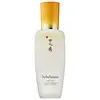What's inside
What's inside
 Key Ingredients
Key Ingredients

No key ingredients
 Benefits
Benefits

 Concerns
Concerns

 Ingredients Side-by-side
Ingredients Side-by-side

Water
Skin ConditioningGlycerin
HumectantDimethicone
EmollientMethyl Gluceth-20
HumectantButylene Glycol
HumectantPEG-15 Glyceryl Isostearate
EmulsifyingPanax Ginseng Root Powder
Skin ConditioningAlcohol Denat.
AntimicrobialPolyglycerin-3
HumectantGlyceryl Polymethacrylate
Pvp
Emulsion Stabilising1,2-Hexanediol
Skin ConditioningAmmonium Acryloyldimethyltaurate/Vp Copolymer
Acrylates/C10-30 Alkyl Acrylate Crosspolymer
Emulsion StabilisingJuglans Regia Shell Powder
AbrasiveTromethamine
BufferingXanthan Gum
EmulsifyingParfum
MaskingPropanediol
SolventDisodium EDTA
Limonene
PerfumingHoney
HumectantMethoxy PEG-114/Polyepsilon Caprolactone
BufferingNelumbo Nucifera Flower Extract
Skin ConditioningPolygonatum Officinale Rhizome/Root Extract
Skin ConditioningRehmannia Glutinosa Root Extract
Skin ConditioningPaeonia Albiflora Root Extract
Skin ConditioningLilium Candidum Bulb Extract
Skin ConditioningPanax Ginseng Root Extract
EmollientOldenlandia Diffusa Extract
Skin ConditioningGlycyrrhiza Uralensis Root Extract
Skin ConditioningPhenoxyethanol
PreservativeHydrolyzed Ginseng Saponins
Skin ConditioningEthylhexylglycerin
Skin ConditioningWater, Glycerin, Dimethicone, Methyl Gluceth-20, Butylene Glycol, PEG-15 Glyceryl Isostearate, Panax Ginseng Root Powder, Alcohol Denat., Polyglycerin-3, Glyceryl Polymethacrylate, Pvp, 1,2-Hexanediol, Ammonium Acryloyldimethyltaurate/Vp Copolymer, Acrylates/C10-30 Alkyl Acrylate Crosspolymer, Juglans Regia Shell Powder, Tromethamine, Xanthan Gum, Parfum, Propanediol, Disodium EDTA, Limonene, Honey, Methoxy PEG-114/Polyepsilon Caprolactone, Nelumbo Nucifera Flower Extract, Polygonatum Officinale Rhizome/Root Extract, Rehmannia Glutinosa Root Extract, Paeonia Albiflora Root Extract, Lilium Candidum Bulb Extract, Panax Ginseng Root Extract, Oldenlandia Diffusa Extract, Glycyrrhiza Uralensis Root Extract, Phenoxyethanol, Hydrolyzed Ginseng Saponins, Ethylhexylglycerin
Ingredients Explained
These ingredients are found in both products.
Ingredients higher up in an ingredient list are typically present in a larger amount.
1,2-Hexanediol is a synthetic liquid and another multi-functional powerhouse.
It is a:
- Humectant, drawing moisture into the skin
- Emollient, helping to soften skin
- Solvent, dispersing and stabilizing formulas
- Preservative booster, enhancing the antimicrobial activity of other preservatives
Butylene Glycol (or BG) is used within cosmetic products for a few different reasons:
Overall, Butylene Glycol is a safe and well-rounded ingredient that works well with other ingredients.
Though this ingredient works well with most skin types, some people with sensitive skin may experience a reaction such as allergic rashes, closed comedones, or itchiness.
Learn more about Butylene GlycolDisodium EDTA plays a role in making products more stable by aiding other preservatives.
It is a chelating agent, meaning it neutralizes metal ions that may be found in a product.
Disodium EDTA is a salt of edetic acid and is found to be safe in cosmetic ingredients.
Learn more about Disodium EDTAHoney comes from bees. It is mainly made up of the sugars fructose and glucose.
Besides sugar, honey also contains amino acids, peptides, Vitamins A, C, and E. Vitamins A, C, and E.
As a humectant, honey is great at hydrating the skin. Humectants draw moisture from the air and hold it to your skin.
Honey also has antioxidant and antioxidant properties. Fun fact: darker honey has more antioxidants than light honey.
The antibacterial property of honey may make it effective at helping to treat acne. We recommend speaking with a professional if you have concerns.
Many people wonder if honey is vegan. It is technically a byproduct from bees. This is because honey is created from the digestive enzymes in a bee's stomach.
Remember to be kind to bees :) They are important for many ecosystems and are endangered.
Learn more about HoneyLimonene is a fragrance that adds scent and taste to a formulation.
It's found in the peel oil of citrus fruits and other plants such as lavender and eucalyptus. The scent of limonene is generally described as "sweet citrus".
Limonene acts as an antioxidant, meaning it helps neutralize free radicals.
When exposed to air, oxidized limonene may sensitize the skin. Because of this, limonene is often avoided by people with sensitive skin.
The term 'fragrance' is not regulated in many countries. In many cases, it is up to the brand to define this term. For instance, many brands choose to label themselves as "fragrance-free" because they are not using synthetic fragrances. However, their products may still contain ingredients such as essential oils that are considered a fragrance.
Learn more about LimoneneParfum is a catch-all term for an ingredient or more that is used to give a scent to products.
Also called "fragrance", this ingredient can be a blend of hundreds of chemicals or plant oils. This means every product with "fragrance" or "parfum" in the ingredients list is a different mixture.
For instance, Habanolide is a proprietary trade name for a specific aroma chemical. When used as a fragrance ingredient in cosmetics, most aroma chemicals fall under the broad labeling category of “FRAGRANCE” or “PARFUM” according to EU and US regulations.
The term 'parfum' or 'fragrance' is not regulated in many countries. In many cases, it is up to the brand to define this term.
For instance, many brands choose to label themselves as "fragrance-free" because they are not using synthetic fragrances. However, their products may still contain ingredients such as essential oils that are considered a fragrance by INCI standards.
One example is Calendula flower extract. Calendula is an essential oil that still imparts a scent or 'fragrance'.
Depending on the blend, the ingredients in the mixture can cause allergies and sensitivities on the skin. Some ingredients that are known EU allergens include linalool and citronellol.
Parfum can also be used to mask or cover an unpleasant scent.
The bottom line is: not all fragrances/parfum/ingredients are created equally. If you are worried about fragrances, we recommend taking a closer look at an ingredient. And of course, we always recommend speaking with a professional.
Learn more about ParfumWater. It's the most common cosmetic ingredient of all. You'll usually see it at the top of ingredient lists, meaning that it makes up the largest part of the product.
So why is it so popular? Water most often acts as a solvent - this means that it helps dissolve other ingredients into the formulation.
You'll also recognize water as that liquid we all need to stay alive. If you see this, drink a glass of water. Stay hydrated!
Learn more about Water